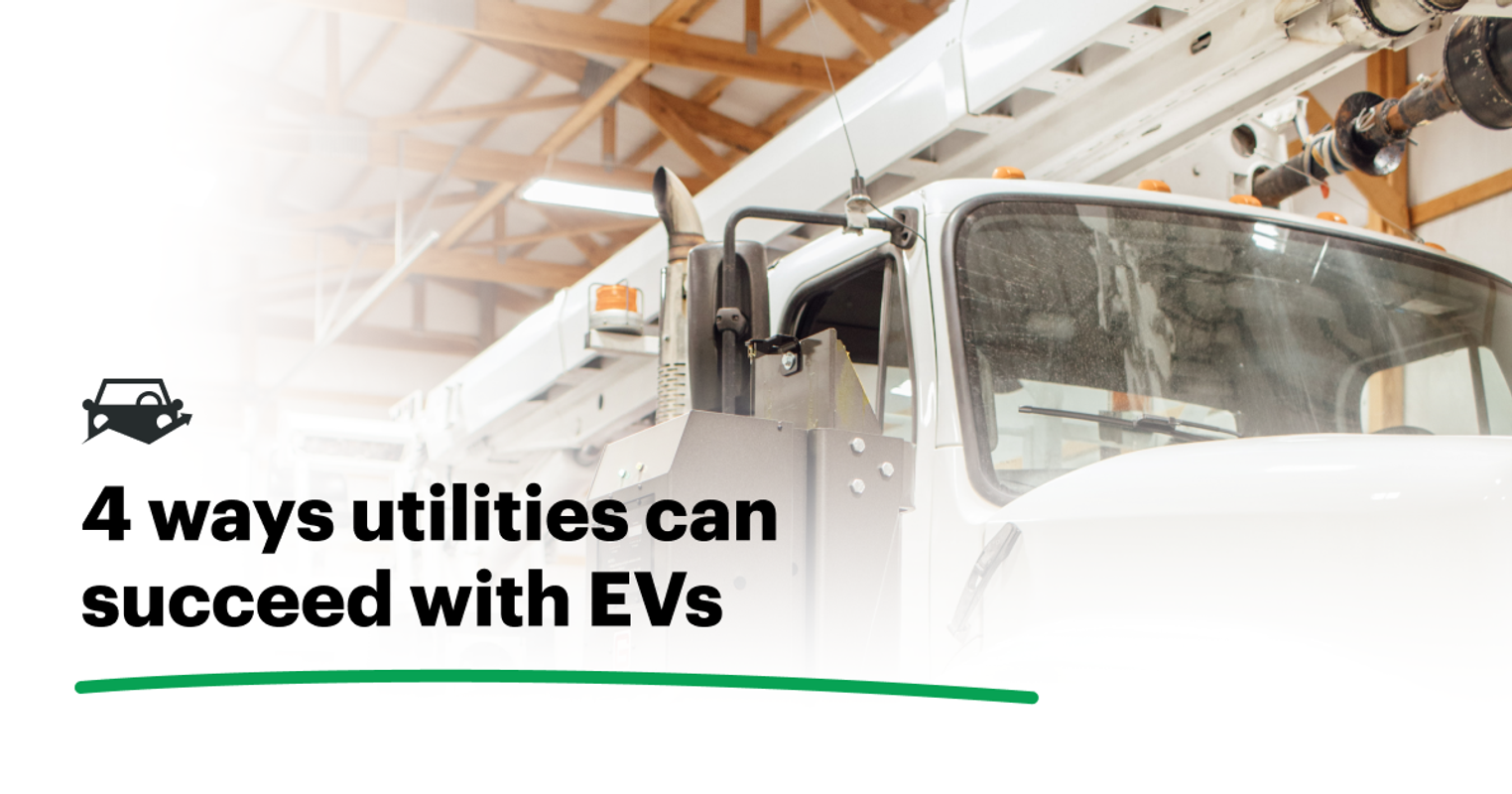How Utility Fleets Can Lead the Way in Fleet Electrification
The relationship between utilities and electric vehicles has a strangely connected impact – as demand for EVs expands, electric utilities especially may find themselves in the interesting role of benefiting from the simultaneous expansion of charging infrastructure and the growing necessity of addressing commercial electric fleet requirements.
Apr 4, 2024
6 min read

Electric utility fleets are also in a unique position to lead the adoption of EV assets in the fleet industry as a whole – their average fleet sizes, knowledge of EV site needs and power storage generation and capacity make them incredibly well-positioned to navigate the transition smoothly. Because fleets contribute so much to greenhouse gas emissions – nearly 25% of carbon emissions can be attributed to the fleet industry – it’s important for utility fleets to embrace their role in mitigating environmental impact with EV adoption as they work on projects to expand the network of services necessary to support widespread electrification.
Understand the Landscape
Before diving headfirst into electrification, it's important to grasp the evolving terrain of EV adoption in the fleet industry. According to a 2023 report from Accenture, there are a few internal barriers that lead in roadblocking fleets from moving forward with electrification, including:
- High upfront costs with no clear business case
- Difficulty installing EV charging infrastructure and poor public infrastructure
- Internal impediments like lack of senior level prioritization or driver/technician buy-in. ⠀ Despite these widespread industry challenges, many utility companies and the states they occupy have set ambitious goals for electrification, according to an analysis from consultant ScottMadden, with two-thirds of some of the largest investor-owned utility fleets surveyed committing to partial electrification by 2030 and nearly a third aiming for full electrification by that time.
For utilities on the path to fleet electrification, there are a few things you can do as you forge ahead to ensure a more effective transition to EVs.
Formulate your business case
Embarking on an electrification journey means having a solid business case to get proper buy-in from your organization as a whole. This should ideally involve clearly outlining the upfront costs, EV fleet benefits and potential challenges associated with transitioning to electric vehicles.
A few tips for creating an effective business case:
- Be able to directly quantify things like maintenance cost savings and carbon emissions reductions
- Don’t be afraid to make a case for potential non-data tangible impacts in industry through things like change leadership and industry reputation
- Utilize any state regulations or penalties that may have an impending effect on your fleet if you fail to meet electrification benchmarks, and likewise factor in any potential tax credits or EV incentives you may receive for achieving those benchmarks. ⠀
Craft an electrification roadmap
Knowing you want to electrify is important, but it’s even more vital to develop a detailed roadmap, so you can chart an achievable course toward a fully electrified fleet. This roadmap should delineate clear goals, milestones and strategies to meet those goals and milestones. Whether it's targeting light-duty vehicles initially or incorporating medium and heavy-duty vehicles over time, a well-crafted roadmap ensures alignment, tracks continued progress and solicits feedback from stakeholders.
Roadmapping often involves creating tiered goals so you can get a more granular look into each step of your process toward your eventual goal. Maybe your 10,000-foot view is full electrification by 2030, but you’ll want to create smaller segments of achievement by narrowing down those goals into a secondary tier (year to year and then quarter to quarter) and then finding individual goals you can achieve within those segments (i.e. disposing 10 aging ICE assets and replacing with EVs, or conducting a site audit for electric vehicle charging).
Utility fleets trust Fleetio
”I would be lost without Fleetio. I'm just being honest. I mean, it's our lifeblood right now. It really is."
Read Scobee Powerline’s StoryManage change effectively
Transitioning to electric fleets will mean some pretty significant operational changes for your fleet, including new maintenance needs, driver training requirements and EV-specific inspection procedures. This will likely necessitate meticulous change management from fleet managers as they navigate their roadmap to ensure that the organization has the information and resources to grow with the fleet as it electrifies.
Utility fleet managers should be sure to anticipate and address any operational shifts in a timely manner, including documenting current vehicle inventories, assessing charging needs and training staff. It’s also important to be certain that all of your systems are geared toward electrification as well, including your fleet management platforms – any software should be able to be customized to accommodate your new EV asset management needs and their specifications alongside your traditional ICE assets.
Proactively managing change can be a key step for ensuring seamless operations and maintaining service levels amid the transition to EVs over the years.
Engage stakeholders for success
Stakeholder engagement, both at the top of your industry and from your direct reports, can be the linchpin for successful electrification integration. Utility fleet managers must be careful to collaborate with regulators, governments and industry organizations to garner support, align goals and navigate regulatory landscapes, while also creating an electric-friendly environment in their company.
- Regulators and state governments are not only the people setting the standard you’re trying to adhere to – they can be great resources and advocates for sustainability. Staying connected is a great way to stay ahead of the curve and get top-down buy-in for your progress toward electrification.
- Industry organizations will be a great source of learning and benchmarking as you pursue electrification. Be sure to stay engaged by attending conferences and networking to form connections that can advance your knowledge of the electrification journey and maybe even work together to solve some common challenges.
- The best way to keep your company’s leadership on board is by presenting a solid business case and roadmap, as well as providing consistent updates and data collection on your electrification goals.
- Drivers and technicians will require some level of visibility into the process of electrification – be sure to stay transparent about goals and progress toward those goals, and provide ample opportunities for both training and feedback. ⠀
Looking Ahead: Strategies for Success
As utility fleet managers embark on the electrification journey, there are several helpful strategies that can create an environment for successful EV fleet management:
- Industry leadership: Electric utility fleets are uniquely suited to leading the way in EV adoption, because they stand to benefit the most from expanding EV power infrastructure requirements, so they should be sure to embrace their role in leading the charge. ⠀
- Strategic planning: Develop a robust electrification strategy tailored to the unique needs and objectives of your utility fleet. ⠀
- Collaboration: Foster collaboration with stakeholders, including regulators, governments and industry peers, to navigate regulatory frameworks and drive collective action. ⠀
- Training and education: Prioritize training and education initiatives to equip your staff with the knowledge and skills required to embrace electric vehicles and charging infrastructure effectively. ⠀
- Continuous monitoring and adaptation: Continuously monitor progress and adapt strategies based on evolving conditions and technologies, ensuring alignment with organizational goals and industry trends.
Electrifying utility fleets can be a great opportunity for utilities to forge new paths to sustainability, innovation and operational efficiency in the fleet industry at large. By formulating a robust business case, crafting a comprehensive roadmap, managing change effectively, and engaging stakeholders proactively, Utility fleet managers should be able to navigate the electrification journey with confidence by building a great business case, solid roadmapping and effective change management. Embracing electrification isn't a simple choice but it's also a strategic imperative for utility fleets who want to drive positive change and shape a sustainable future.
Electrify and scale with Fleetio
If you’re looking to electrify in the coming years, you need a fleet management platform that can grow with you.
Get a free demo
Senior Fleet Content Specialist
As a Senior Fleet Content Specialist at Fleetio, Peyton explores the voices and experiences that shape fleet operations. She focuses on how fleet professionals adopt technology, improve efficiency and lead their teams to bring clarity and context to the challenges happening across the industry.
View articles by Peyton PanikReady to get started?
Join thousands of satisfied customers using Fleetio
Questions? Call us at 1-800-975-5304
Get Our Newsletter
Join a community of 70,000+ fleet industry professionals.

